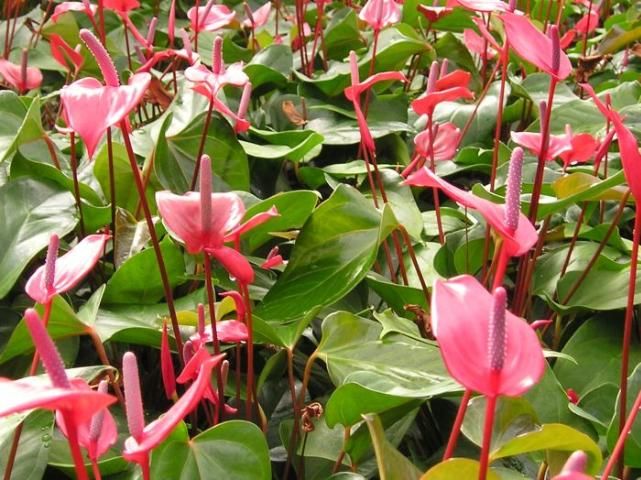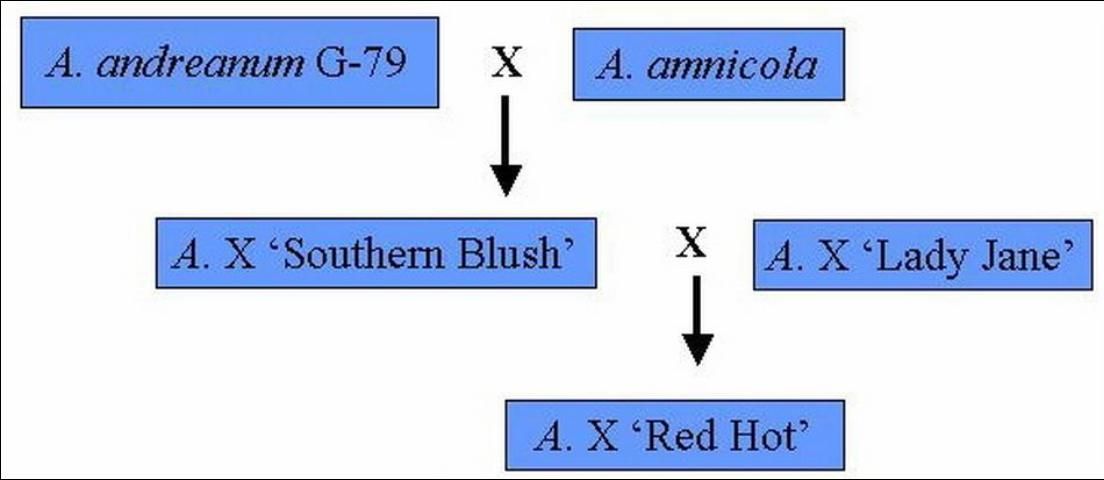Anthurium X 'Red Hot' (Figure 1) is an interspecific hybrid developed by the Foliage Plant Breeding and Genetics Research Program at UF/IFAS Mid-Florida Research and Educational Center—Apopka as a flowering potted foliage plant. Anthurium (Anthurium andreanum Linden ex Andre (family: Araceae) has been traditionally developed and grown for cut flower production because of its showy red, orange, pink, or white spathes (Kamemoto and Kuehnle 1996). The large overall size, long petioles and peduncles on the cut flower selections generally preclude their use as container plants. Recently, new Anthurium varieties are being developed to emphasize a smaller overall plant size, a propensity to produce basal shoots and a highly prolific flowering habit. Such hybrids are readily adaptable for flowering pot plant production. Anthurium X 'Red Hot' is one such hybrid with numerous attractive, bright red spathes and a compact, well-branched growth habit.

Origin
Anthurium X 'Red Hot' originated from a cross using A. amnicola Dressler as one parent. This parent is a dwarf species bearing small, pale lavender spathes. It has a naturally clumping growth habit. It was crossed with an unnamed selection of A. andreanum G-79 that had large pink spathes. One of the F1 seedlings was then used as the female parent in a cross with Anthurium X 'Lady Jane'. This produced the progeny from which Anthurium X 'Red Hot' was selected. The pedigree for Anthurium 'Red Hot' is shown below (Figure 2).

Description
Leaves of Anthurium X 'Red Hot' are dark green (RHS 147A), lance shaped, 18 to 20 cm (7.5 to 8 inches) long and 11 to 12 cm (4 to 5 inches) wide near the base. Petioles are 26 to 34 cm (10.5 to 13.5 inches) long. The peduncle color is gray-orange (RHS 171B) and rises 20 to 28cm (8 to 11.5 inches) above the soil surface when the spathe is fully open. Spathes are 6 to 7 cm (2.5 to 3 inches) long and 4 to 5 cm (1.5 to 2 inches) wide. The spathes are medium red (RHS 47B) when the flower first opens, and gradually change to a lighter red (RHS 48B) with age. The spadices are orange-red (RHS 34A) at the tip and blend into red (RHS 53B) at the base. The spadices measure 3 to 4 cm long (1.25 to 1.5 inches) and 5 to 6 mm (0.2 inches) wide. Anthurium 'Red Hot' has grayed-orange peduncles (RHS 171B). The flowers (spathes and spadices) are held slightly above the foliage canopy (Henny 1999).
Performance
Performance characteristics of Anthurium X 'Red Hot' were determined in a controlled greenhouse growth study. Thirty liners were selected from well-rooted cuttings in 25-mm (72 insert) cell trays. Liners were potted into 1.6L (6-inch) plastic pots containing a growing medium of 3:2 Canadian peat: Perlite by volume. The soil was amended with 0.9 kg m-3 of Micromax, (Sierra Chemical Company, Milpitas, CA) and 4.1 kg m-3 dolomite. Plants were grown in a shaded greenhouse with a maximum irradiance of 125µmol s-1m-2 under a natural photoperiod and a temperature range of 15 to 34°C (63 to 97°F). Ten plants were grown at each of three fertilizer levels [Osmocote (sierra Chemical Company) 19N-2.6P-10K equivalent to 5.25, 7.0, or 8.75 kg m-2 N per year in a completely randomized design. At the end of the test, data recorded included canopy height and width, length and width of largest leaf, number of basal shoots and number of open flowers. In addition, plants were rated for visual quality on a scale of 1 to 5, where 1 = dead, 3 = acceptable, and 5 = excellent quality.
Anthurium X 'Red Hot' reached marketable size in 11 months. Fertilizer level did not significantly affect any of the variables measured. All plants were rated between good and excellent at each fertilizer level as overall plant quality averaged 4.7 out of a possible 5.0. Mature plants were wider than they were tall. Canopy height and width averaged 27.0 cm by 47.5 cm (10.8 by 19 inches) respectively, for the 1.6L (6 inch) pot size. Leaf length 19 cm (7.5 inches) was about twice as long as width 11 cm (4.5 inches). Plants were well branched with an average of 6.2 basal shoots per plant. Both primary and secondary shoots produced blooms. Average open flower count per plant was 4.6.
Surviving well under interior low-light conditions is one of the most important criteria to judge foliage plant performance and, ultimately, consumer satisfaction. Subsequent experiments have shown that Anthurium 'Red Hot' is able to adapt to low-light interior conditions. 'Red Hot' manages to sustain a positive net photosynthesis rate and change its overall morphology by increasing in canopy width to height ratio. Leaves extend out as opposed to lying down, which allows interception of more light. In this manner 'Red Hot' shows good adaptation to low-light levels and is able to sustain net photosynthetic activity and maintain flower production for several months under low light conditions. For more information see (Chen and Henny 2007).
Availability
Anthurium X 'Red Hot' has been patented (US Plant Patent No. PP09355). It is intended for commercial producers growing finished plants in 1.6 or 3.9L (6-inch or 8-inch) containers (Figure 3). Plant patent rights have been assigned to the Florida Foundation Seed Producers. Stock plants have been released to University of Florida licensed cooperating Florida tissue culture labs for propagation and distribution. Inquiries regarding participating labs may be obtained by writing the Florida Foundation Seed Producers, Inc., PO Box 309, Greenwood, FL 32443. Plants for research purposes may be obtained directly from the author.

References
Chen, J. and R. Henny. 2007. An adaptable Anthurium. Ornamental Outlook. May:27.
R.J Henny. 1999. 'Red Hot' Anthurium. HortScience 34(1):153–154.
Kamemoto, H. and A.R. Kuehnle. 1996. Breeding Anthuriums in Hawaii. Univ. of Hawaii Press. 132p.
Royal Horticultural Society. 1995. The Royal Horticultural Society Colour Chart. 3rd ed. Royal Horticulture Society, London.